Contributory members are able to log private notes and comments about each site
Sites theCAptain has logged. View this log as a table or view the most recent logs from everyone
Menhir de la Demoiselle de Bracqueville
Trip No.206 Entry No.5 Date Added: 25th Mar 2020
Site Type: Standing Stone (Menhir)
Country: France (Normandie:Calvados (14))
Visited: Yes on 28th Sep 2006. My rating: Condition 3 Ambience 3 Access 4
Menhir de la Demoiselle de Bracqueville submitted by thecaptain on 11th Oct 2006. To visit this stone, find your way from Beny-sur-Mer to the south along small tracks to Bracqueville farm. Park near to the farm, and walk about 500 metres along the track which passes in front of the farm till you get to a junction of trackways. Take the grassy track to the left, and the menhir is a further 500 metres along and just into the field on the left.
(View photo, vote or add a comment)
Log Text: Found this at last, on probably my third attempt. Find your way from Beny-sur-Mer to the south along small tracks to Bracqueville farm. Park near to the farm, and walk about 500 metres along the track which passes in front of the farm till you get to a junction of trackways. Take the grassy track to the left, and the menhir is a further 500 metres along and just into the field on the left.
Its about 1.4 metres tall, 0.7 metres wide and 0.3 metres thick, and leaning towards the north. The farmer has left very little room around it, and it has some very recent scrapes and damage done to it, no doubt from farm machinery. It is likely that this menhir often gets obscured by crops in the summer. Nice to have found it, its a nice stone. Stupidly I forgot to take my gps with me to get a proper position.
Menhir de la Demoiselle de Bracqueville
Trip No.202 Entry No.4 Date Added: 25th Mar 2020
Site Type: Standing Stone (Menhir)
Country: France (Normandie:Calvados (14))
Visited: Couldn't find on 23rd Apr 2005
Menhir de la Demoiselle de Bracqueville submitted by thecaptain on 11th Oct 2006. la Demoiselle de Bracqueville, near Caen in Calvados. Its about 1.4 metres tall, and leans towards the north.
The farmer has left very little room around it, and it has some very recent scrapes and damage done to it, no doubt from farm machinery.
(View photo, vote or add a comment)
Log Text: Despite being marked on the ign map and having a description of how to find this 1.4 metre tall stone I could find no reasonable place to park down the farm track to Bracqueville before a 500 metre walk so didn’t bother. I could see no sign of the stone from anywhere in the vicinity.
Pierre Tourneresse, Cairon
Trip No.202 Entry No.5 Date Added: 25th Mar 2020
Site Type: Chambered Tomb
Country: France (Normandie:Calvados (14))
Visited: Yes on 23rd Apr 2005. My rating: Condition 4 Ambience 4 Access 4
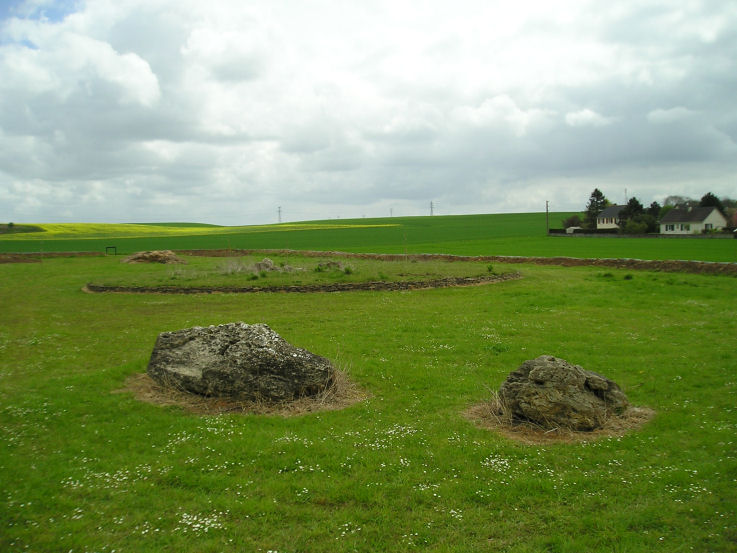
Pierre Tourneresse, Cairon submitted by thecaptain on 28th Apr 2005. Pierre Tourneresse, Cairon. Seen here looking towards the remains of the large round burial mound from beyond the two large stones which are the remains of the capstone from the main chamber - removed and destroyed by the Germans during the '39-45 war.
(View photo, vote or add a comment)
Log Text: I wasn’t expecting to find much here if anything at all as all the information I had of this site was a menhir symbol on my ign map. But as I was passing I decided to have a look anyway and luckily stopped to look at my map right by a little road at the east of the southern end of the village with a sign to “Pierre Tourneresse”. So I followed it down to the end of a little modern housing estate and parked. A further signpost at the end of the road points to Pierre Tourneresse 300 metres distant. Turn left here and stick to the back of the houses rather than go straight on up the hill.
What a lovely site this is. In a little dip down near the stream is a newly made and signposted enclosure which at the time of my visit was still under construction with a ring of trees being planted well around the outside of it. Inside the enclosure is the remains of a large approximately round cairn which has a diameter of about 19 metres and is edged all around with dry stone walling within which are two chambers.
The main chamber is large stone lined chamber in approximately the middle of the cairn which has a seven metre long entrance passage which exits to the east of the cairn at a bearing of 100° magnetic. The chamber is approximately rectangular dimensions about 4 to 5 metres in length by 3 metres in width and is made with large upright slabs with drystone walling between. At various positions around this large chamber there seem to be smaller alcoves or features. The second much smaller chamber opens to the west side and is positioned approximately opposite to the main chamber entrance with an alignment of 269°. It is about 3.5 metres long and opens up to about 2 metres in width at its maximum. It is made with drystone walling only and has a ledge of some sort along its northern side.
Outside the cairn at a distance of about 15 metres in a northwesterly direction are two very large stones. I wondered whether these were once menhirs which marked the position of the cairn (these northern French cairns are often associated with menhirs) and which would explain the marking of menhir on the ign maps. Looking at these stones more closely however suggested that it is much too wide to have been a menhir so I wondered whether the stones were the remains of the chamber capstone. I spent quite a lot of time here the place seemed to give off a nice happy atmosphere which was probably helped by the fact that for once one of these much neglected ancient Normandy monuments is being lovingly cared for and looked after what was probably many years of neglect.
As I was leaving I met a man walking his dog and asked if he knew anything about the site. By an amazing stroke of luck I had met one of the few people in France who has an interest in these ancient sites and who collects flint artefacts ! Despite the language problems we talked for about half an hour about things. He told me that the cairn had been much more complete up until the war during which the Germans had used it as a shelter and gun emplacement. As they were leaving after the D-Day invasion they went about destroying it and the two large stones are indeed the remains of the capstone to the main chamber. He also told me that an excavation of the site was done 5 years ago and the restoration has been going on since then.
We got on to discussing other sites in the region and other than the various sites I knew about (he was surprised indeed to find an Englishman who knew anything about any of these places and seemed very interested when I told him I intended to write a book) and he told me of a menhir nearby he knew which was destroyed only a couple of years ago by a farmer who didn’t want it in the middle of one of his fields. He also showed me on my map a couple of places where he goes to find flint items one of which he called a quarry. He said that if I went to one of these places he showed me then if the fields were recently ploughed I would almost certainly find some worked flint items and that he had a collection of over 700 items. He also then told me in detail how to find the two polisher stones near Mont Joly which was of great interest as I would probably not have even looked if I had no detailed information to go on. It was very nice to meet a man like this particularly on my first real day of French stonehunting and it made me think that the whole trip is going to go well.
La Hogue
Trip No.202 Entry No.6 Date Added: 25th Mar 2020
Site Type: Chambered Tomb
Country: France (Normandie:Calvados (14))
Visited: Saw from a distance on 23rd Apr 2005
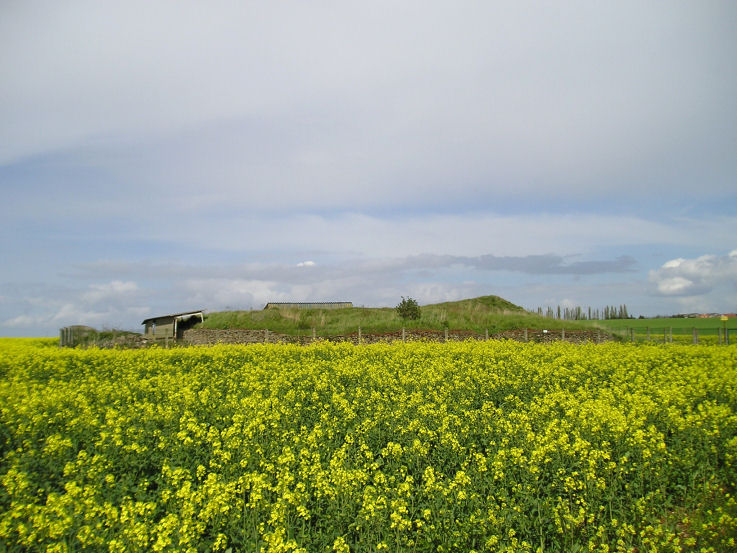
La Hogue submitted by TheCaptain on 6th May 2005. La Hogue Tumulus, Fontenay-le Marmion, Calvados
The excavated remains of this large round barrow with 12 internal burial chambers is fenced off within a field of rapeseed. What was once a guardian with a key to the site in the nearby house was today a lady who told me that “Il est fermée monsieur”.
(View photo, vote or add a comment)
Log Text: Despite being signed from the main road and having a Bar le Tumulus nearby the excavated remains of this large round barrow with 12 internal burial chambers is fenced off within a field of rapeseed. What was once a guardian with a key to the site in the nearby house was today a lady who told me that “Il est fermée monsieur”.
La Hoguette
Trip No.202 Entry No.7 Date Added: 25th Mar 2020
Site Type: Chambered Tomb
Country: France (Normandie:Calvados (14))
Visited: Yes on 23rd Apr 2005. My rating: Condition 1 Ambience 1 Access 5

La Hoguette submitted by TheCaptain on 6th May 2005. La Hoguette Tumulus, Fontenay-le Marmion, Calvados.
Despite all my records stating that this large round tumulus with 8 passage graves no longer exists, the remains are quite easy to find within the village. It remains today as a green grassy area within a housing estate, surrounded by roads called something like Rue la Tumulus and Rue La Hoguette. There is a large diameter mound with a slight hollow in the middle, and remains of some form of signpost.
(View photo, vote or add a comment)
Log Text: Despite all records stating that this large round tumulus with 8 passage graves is no longer there the remains are quite easy to find within the village. It remains today as a green grassy area within a housing estate surrounded by roads called something like Rue la Tumulus and Rue La Hoguette. There is a large diameter mound with a slight hollow in the middle and remains of some form of signpost.
Pierre Tourneresse (Gouvix)
Trip No.202 Entry No.8 Date Added: 25th Mar 2020
Site Type: Standing Stone (Menhir)
Country: France (Normandie:Calvados (14))
Visited: Couldn't find on 23rd Apr 2005
Pierre Tourneresse (Gouvix) submitted by Rida on 29th Jan 2011. Site in Normandie:Calvados (14) France
(View photo, vote or add a comment)
Log Text: Not marked on my ign map and finding no map within the village I gave up without really trying to find the supposed menhir near here. I believe it is in the grounds of the local chateau and wasn’t going to spend a lot of time being unable to find it.
Bretteville-le-Rabet
Trip No.202 Entry No.9 Date Added: 25th Mar 2020
Site Type: Ancient Mine, Quarry or other Industry
Country: France (Normandie:Calvados (14))
Visited: Yes on 23rd Apr 2005. My rating: Condition 2 Ambience 2 Access 5

Bretteville-le-Rabet submitted by TheCaptain on 8th May 2005. Bretteville-le-Rabet flint quarries, Calvados.
I spent just 5 minutes looking around the edge of this freshly ploughed field and found four bits of worked flint, including a nice scraper tool.
(View photo, vote or add a comment)
Log Text: Not marked on any map I was told of this place by a man who collects flint artefacts I met at Cairon so I went for a quick look. Nothing much to see but the fields here were freshly ploughed and within 5 minutes of looking along the edges of the fields by the roadside I had found 4 worked flint artefacts.
La Butte du Hu
Trip No.202 Entry No.10 Date Added: 25th Mar 2020
Site Type: Chambered Cairn
Country: France (Normandie:Calvados (14))
Visited: Saw from a distance on 23rd Apr 2005
La Butte du Hu submitted by thecaptain on 8th Oct 2006. Plan of La Butte du Hu, Ernes, as shown on the sign at Colombiers-sur-Seulles.
(View photo, vote or add a comment)
Log Text: North of the village of Ernes several hundred metres up a farm track from the hamlet of Vey d’Ifs on the top of the ridge this large chambered tumulus can be seen just within a field growing crops so I did not enter.
La Pierre Cornue
Trip No.202 Entry No.11 Date Added: 25th Mar 2020
Site Type: Standing Stone (Menhir)
Country: France (Normandie:Calvados (14))
Visited: Yes on 23rd Apr 2005. My rating: Condition 4 Ambience 3 Access 5

La Pierre Cornue submitted by TheCaptain on 6th May 2005. La Pierre Cornue, a more than 4 metres tall menhir.
(View photo, vote or add a comment)
Log Text: A very large menhir in disturbed ground which looks to be an old stone quarry just behind the Mairie which is just to the west of the main street a few hundred metres south of the church. The menhir is made of a strange sort of stony conglomerate and is a strange shape and contains many holes. It is more than 4 metres high 2.5 metres wide and over a metre thick at the base although the main part of the stone is about half a metre thick.
La Longue Pierre (St-Pierre-Eglise)
Trip No.207 Entry No.7 Date Added: 25th Mar 2020
Site Type: Standing Stone (Menhir)
Country: France (Normandie:Manche (50))
Visited: Yes on 5th Apr 2007. My rating: Condition 4 Ambience 3 Access 4
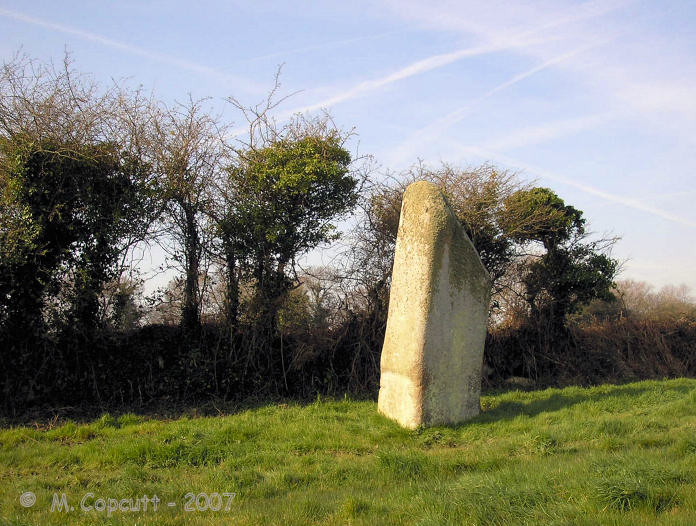
La Longue Pierre (St-Pierre-Eglise) submitted by TheCaptain on 29th Sep 2007. One of the "Three Princesses", this menhir stands 4.2 metres high, perhaps the largest menhir remaining standing in La Manche today.
(View photo, vote or add a comment)
Log Text: I was able to get right to this lovely stone this time, although in a rush as there was nowhere to park and I left the car blocking the little lane. The stone stands about 4 metres tall in a very swampy field, and I got soaking wet feet while walking up to the stone, but at least it washed clean all the mud from La Pierre Plantée. It now has a little information post at the gateway to the field, and is numbered on a marked walk around the village, so I must go and look for more information at St Pierre l'Eglise.
Langrais menhirs
Trip No.202 Entry No.12 Date Added: 26th Mar 2020
Site Type: Standing Stones
Country: France (Normandie:Calvados (14))
Visited: Saw from a distance on 23rd Apr 2005
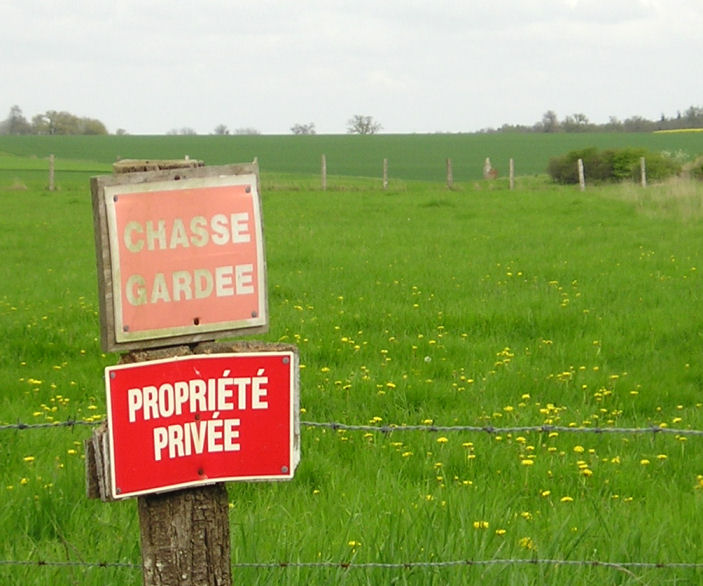
Langrais menhirs submitted by TheCaptain on 6th May 2005. Langrais menhirs, Soumont-Saint-Quentin, Calvados.
2 large menhirs in a field to the east of the village near Mont Joly, but which are 500 metres from the road across a field surrounded by barbed wire and with very clear keep out signs. One of the two menhirs stands 3.6 metres high, while the other is fallen.
The standing menhir can be seen here between the third and fourth fencepost along to the right of the sign.
(View photo, vote or add a comment)
Log Text: Two large menhirs in a field to the east of the village near Mont Joly but which are 500 metres from the road across a field surrounded by barbed wire and with very clear keep out signs. One of the two menhirs stands 3.6 metres high while the other is fallen.
In the region around here are many other large stones some of which may well be fallen menhirs and indeed perhaps a row can be determined in the lane called “Route des Menhirs”.
Langrais menhirs
Trip No.212 Entry No.6 Date Added: 26th Mar 2020
Site Type: Standing Stones
Country: France (Normandie:Calvados (14))
Visited: Yes on 7th May 2012. My rating: Condition 4 Ambience 3 Access 4

Langrais menhirs submitted by Rida on 27th Feb 2011. Site in Normandie:Calvados (14) France
(View photo, vote or add a comment)
Log Text: Having had a good look at the IGN 1:25000 map, I saw that there is a trackway running east from the road south of Mont Joly, which runs from the bottom of the hill diagonally up to the approximate position of the stones. Even better, when arriving there for a look, the trackway was open and easily driveable, and so I took this option on this showery afternoon, and when emerging from below the wood at the top of the hill, there was plenty of space to park amongst a large composting area! Left Dad in the car while I went out into the wind and drizzle to find the stones, and there they were, just round the back of the big pile of manure!
The two stones stand at the edge of an open rocky outcrop at the top of the hill, covered in wildflowers at this time of year, but I learned that the stones are not in their original positions, having been moved there by the farmer at some point in the past. The two stones are very different, the larger stone being a whitish quartz type stone, between 3.5 nd 4 metres tall, while its shorter neighbour is a reddish colour, and only about 1.6 metres tall. There are plently of other large lumps of stone laying about here, which may have been broken from the two menhirs, or just other examples of field clearance.
On the way down from the stones, through a gateway into the wood I could see another rocky outcrop with various large stones standing around, a couple of them probably at least 2 metres tall. This was all now made into a nice garden feature, but is there any ancient significance to the stones? Back onto the road, and I noticed it was called Route des Menhirs, and up towards the top of the hill there was another garden with some large rocks standing in it.
Onto the top of Mont Joly, and it is clear that there are large rocks all over the place, and it is easy to imagine that thee was once an alignement of large stones running along the top of the hill into the ancient settlement. Walking along the edge of the field, and then the pathway to the end of the promontary, and large stones can be seen laying around everywhere, many clearly not just a local outcropping of rock, but various shapes, sizes and types of stone. Many of these rocks were now incorporated into garden features, but many more are just laying there, slowly getting buried by the undergrowth. It really is a fascinating area, and I do wonder what a proper survey of this ancient hilltop would turn up.
Mont Joly
Trip No.202 Entry No.13 Date Added: 26th Mar 2020
Site Type: Ancient Village or Settlement
Country: France (Normandie:Calvados (14))
Visited: Yes on 23rd Apr 2005. My rating: Condition 2 Ambience 4 Access 5

Mont Joly submitted by TheCaptain on 7th May 2005. Mont Joly, Soumont-Saint-Quentin, Calvados.
This is a promontory site surrounded on three sides by the steep gorge of the river Laizon. The site has been inhabited and defended since Paleolithic times, and artefacts have been found from all times since this. It is said that although little ancient remains can be seen, they are everywhere underfoot, and every molehill will contain several flints and pottery sherds.
(View photo, vote or add a comment)
Log Text: This is a promontory site surrounded on three sides by the steep gorge of the river Laizon and the eastern end has been defended by ramparts little of which can now be seen between the church and water tower. The site has been inhabited and defended since Paleolithic times and artefacts have been found from all times since this. It is said that although little ancient remains can be seen they are everywhere underfoot and every molehill will contain several flints and pottery sherds. This region was a major supplier of flint tools in the past and there is much to be found here.
Mont Joly
Trip No.212 Entry No.8 Date Added: 26th Mar 2020
Site Type: Ancient Village or Settlement
Country: France (Normandie:Calvados (14))
Visited: Yes on 7th May 2012. My rating: Condition 2 Ambience 4 Access 5
Mont Joly submitted by theCaptain on 15th Jan 2014. This promontory site is surrounded on three sides by the steep gorge of the river Laizon, and the eastern end has been defended by ramparts, a little of which can now be seen between the church and water tower.
In this picture a raise in the land can be seen to the left of my Dad.
(View photo, vote or add a comment)
Log Text: What an intriguing place this is, and deserving of much more thorough exploration.
Bons Tassilly polissoirs
Trip No.202 Entry No.14 Date Added: 26th Mar 2020
Site Type: Polissoir
Country: France (Normandie:Calvados (14))
Visited: Yes on 23rd Apr 2005. My rating: Condition 3 Ambience 5 Access 4

Bons Tassilly polissoirs submitted by TheCaptain on 6th May 2005. Mont Joly polissoirs, Bons Tassilly, Calvados.
The first of two polissoirs beside the river which forms the gorge surrounding the Mont Joly promontory site.
On the top surface of this stone are two large polished bowl areas, and three grooves, made by polishing the hard stone into tools.
(View photo, vote or add a comment)
Log Text: Two polissoirs can be found beside the river which forms the gorge surrounding the Mont Joly promontory site. Follow signs to the Brèche de Diable park the car and then walk along the footpath which follows the river up this splendid rocky gorge. After several hundred metres the path diverges from the river and starts uphill to the left when you come to a fenced area. At this point go down towards the stream and the two polissoir stones can be found one on each side of the river.
The first one on the near side of the river is a block of hard stone sticking out of the hillside about 2 metres long and a metre wide. On the top surface of this stone are two large polished bowl areas and three grooves made by polishing the hard stone into tools. It is wonderful to sit down on one of the ends of this stone and imagine polishing away to make an axe or similar. In fact I was very tempted to just sit there and make one !
The polissoir on the far side of the stream has now been fenced off within private ground and cannot be reached although can clearly be seen.
Menhir dit Pierre de la Hoberie
Trip No.202 Entry No.15 Date Added: 26th Mar 2020
Site Type: Standing Stone (Menhir)
Country: France (Normandie:Calvados (14))
Visited: Couldn't find on 23rd Apr 2005
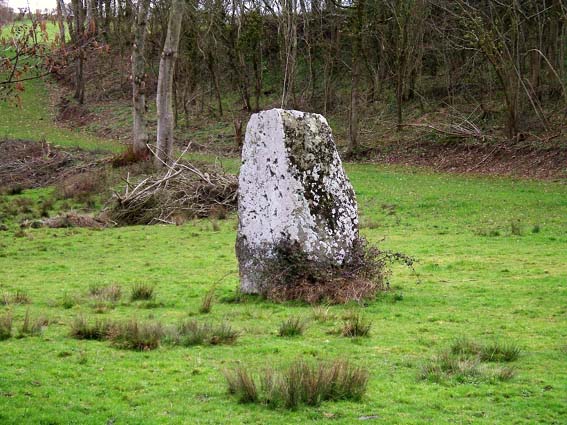
Menhir dit Pierre de la Hoberie submitted by Rida on 27th Feb 2011. Site in Normandie:Calvados (14) France
Menhir dit Pierre de la Hoberie
(View photo, vote or add a comment)
Log Text: This 3.1 metre tall menhir is said to be in the field downhill from the Ferme de Hoberie southwest of the village of Ussy. I could find nowhere to park and see no way through the farm without going through fields of cows so didn’t bother as I was in a rush to get back.
La Loge aux Sarrasins
Trip No.202 Entry No.17 Date Added: 26th Mar 2020
Site Type: Burial Chamber or Dolmen
Country: France (Normandie:Calvados (14))
Visited: Couldn't find on 17th Apr 2005
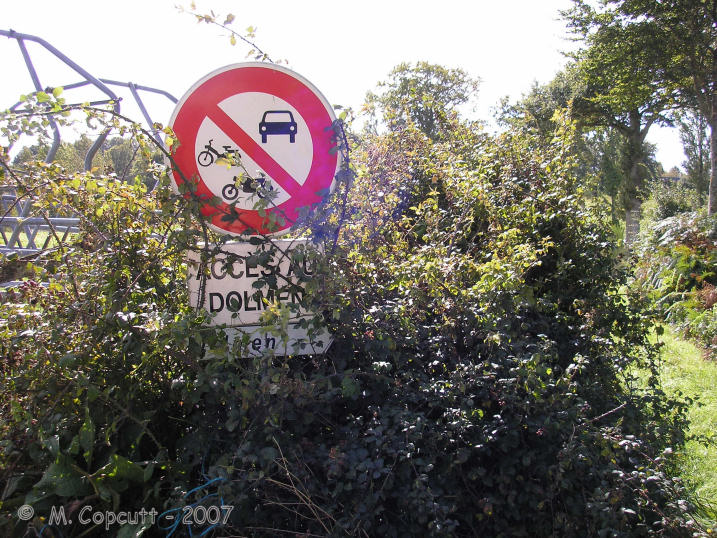
la Loge aux Sarrasins submitted by thecaptain on 28th Sep 2007. Despite the overgrown signs, this looked all very promising, and that I could add this elusive, rare Normandy dolmen to my list !
(View photo, vote or add a comment)
Log Text: Despite an accurate description of how to find this dolmen I could find nothing that looked like the picture from 1980. I did however find some large stones in about the right place a large single stone standing in the middle of the field and a couple of smaller ones with a small stone on top and a further large stone nearby. Perhaps I was looking in the wrong field but I think more likely is that this dolmen has recently been destroyed. A closer inspection of the photographs and I think that the large stone lying near the edge of the field might be the capstone from the dolmen upside down. A criminal shame that these things survive so long only to be destroyed in these modern times due to greed and laziness of a farmer.
Later note. Having seen the 1:25000 ign map of the area the dolmen is marked in a field further to the north than where I was looking beside the farm buildings which begs the question of what are the stones I did find.
La Loge aux Sarrasins
Trip No.211 Entry No.4 Date Added: 26th Mar 2020
Site Type: Burial Chamber or Dolmen
Country: France (Normandie:Calvados (14))
Visited: Yes on 9th Oct 2011. My rating: Condition 4 Ambience 3 Access 4
la Loge aux Sarrasins submitted by hrun95 on 21st Jun 2011. These photos were taken in 2007, in the garden of the owners. So it's a bit boring because you are in their propriety. I get there by the little path coming by la Chaudronniere.
Site in Normandie:Calvados (14) France
(View photo, vote or add a comment)
Log Text: Having gone to Vire for a Vide Grenier and country show, persuaded Trevor and Sara to visit this stone for another look. Followed the same path as last time, and this time, once at the corner of the garden, the dolmen was clear to be seen in the back garden. At Last!
Its a lovely looking little dolmen. I can only assume that last visit there was a shed in the way, preventing it being seen. To get a better view, went back to the cornfield, and walked along its edge and up along outside the garden. I noticed that a bit further to the west, behind the garage, there was a separate standing stone, a couple of metres tall.
Les Cartesières
Trip No.202 Entry No.18 Date Added: 26th Mar 2020
Site Type: Passage Grave
Country: France (Normandie:Manche (50))
Visited: Couldn't find on 24th Apr 2005
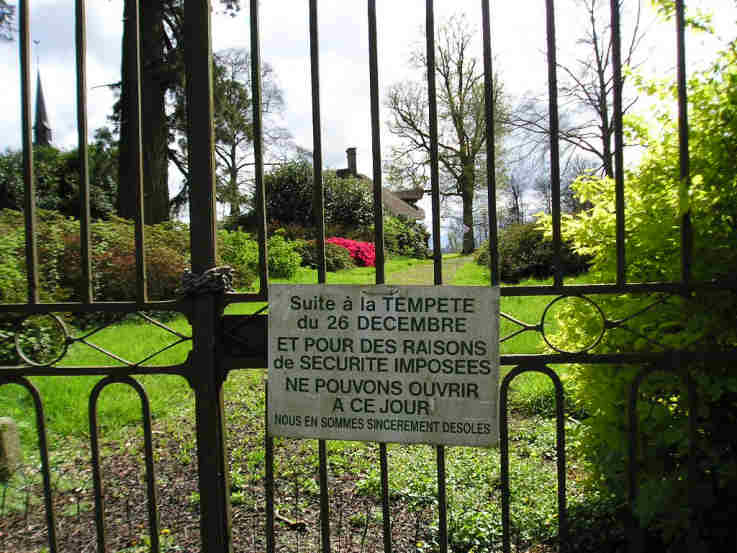
Les Cartesières submitted by TheCaptain on 7th May 2005. Les Cartesières allée couverte, St Symphorien-des-Monts, Manche.
This T shaped gallery grave is found in a zoo park. However, on the day of my visit, this park was well and truly shut, and looked like it hadn’t been open in many years.
(View photo, vote or add a comment)
Log Text: This T shaped gallery grave is the only one of this kind surviving in Normandy and is to be found in a zoo park near to the village. However on the day of my visit this park was well and truly shut and looked like it hadn’t been open in many years and was becoming very decrepit. No chance of getting in to see the monument.
Later note. Having seen the 1:25000 ign map of the area the dolmen is marked beside the little lane which runs down to the lakes along the western edge of the park. In fact its probably almost exactly where I stopped and had a look around to see if I could spot anything. If I am in the area again I will know where to look.
La Table aux Diables (Passais)
Trip No.202 Entry No.19 Date Added: 26th Mar 2020
Site Type: Passage Grave
Country: France (Normandie:Orne (61))
Visited: Yes on 24th Apr 2005. My rating: Condition 4 Ambience 4 Access 5
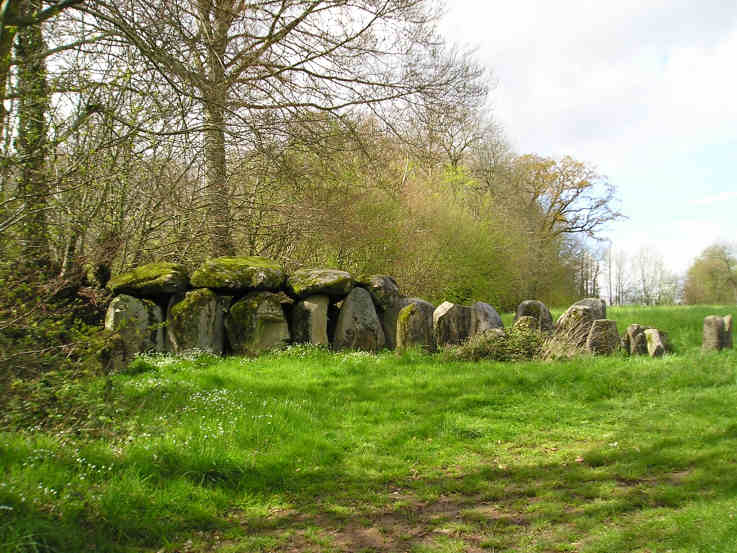
La Table aux Diables (Passais) submitted by TheCaptain on 7th May 2005. La Table aux Diables allée couverte, Passais, Orne.
A surprise find, this smashing little lateral entry Allée Couvert is about 12 or 13 metres in length, seen here from the southeast.
(View photo, vote or add a comment)
Log Text: Blimey what a pleasure to find this monument signposted from the Mantilly to Passais road as well as marked on the ign map. Heading south along the small road just west of Passais and turn right just before a little fishing lake is reached. A few hundred yards up a small track and the monument is found in a field to the right.
A surprise find this is a smashing little lateral entry Allée Couvert is about 12 or 13 metres in length with an orientation of 049° Magnetic. The main chamber is about 1.5 metres in width with 4 large capstones still remaining on 6 pairs of uprights at the western end with a height of 2 metres at the end dropping to 1.5 metres at the open end. The eastern end is more ruinous and the entrance is near the eastern end on the south side. The internal faces of the chamber stones have been nicely smoothed and are very well aligned with each other the gaps being filled with drystone walling. The outer walling of the peristalith is almost complete around the northern side and there are many stones remaining of the cairn filling between the inner and outer walls in the northwest quadrant. Only about half of the outer wall of stones remain on the southern side.
